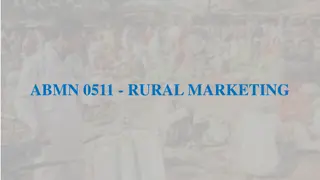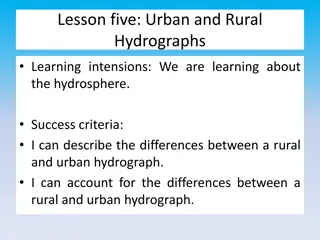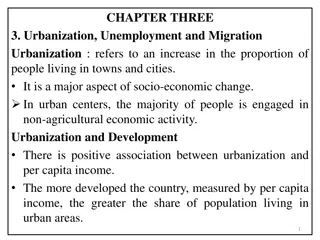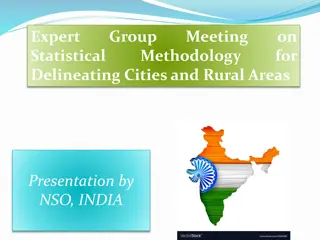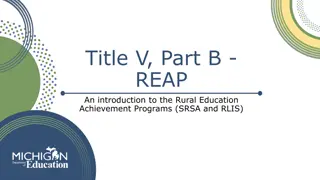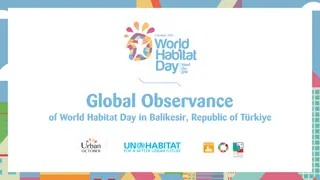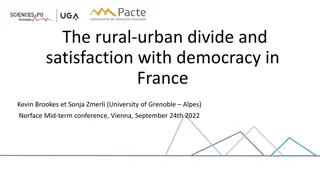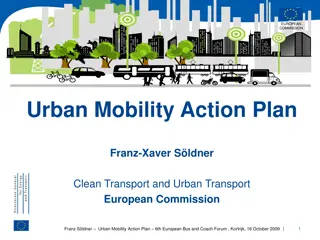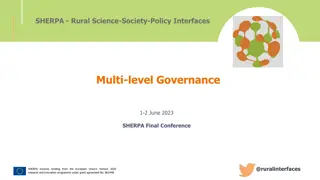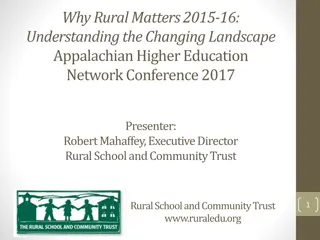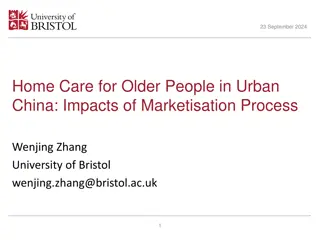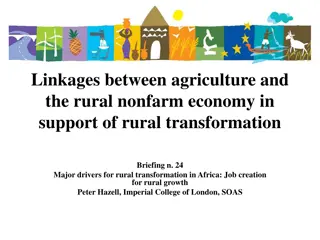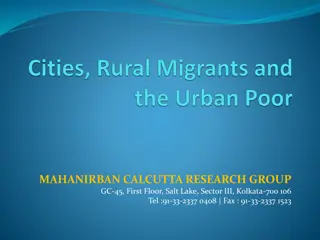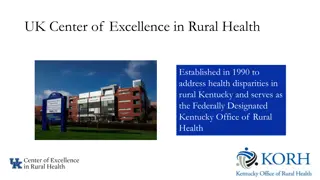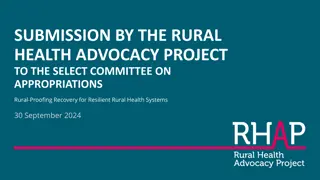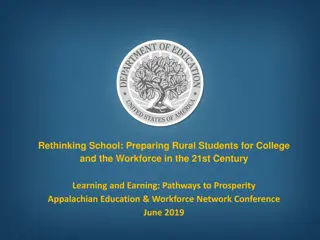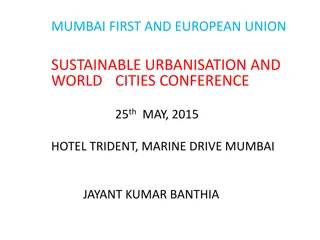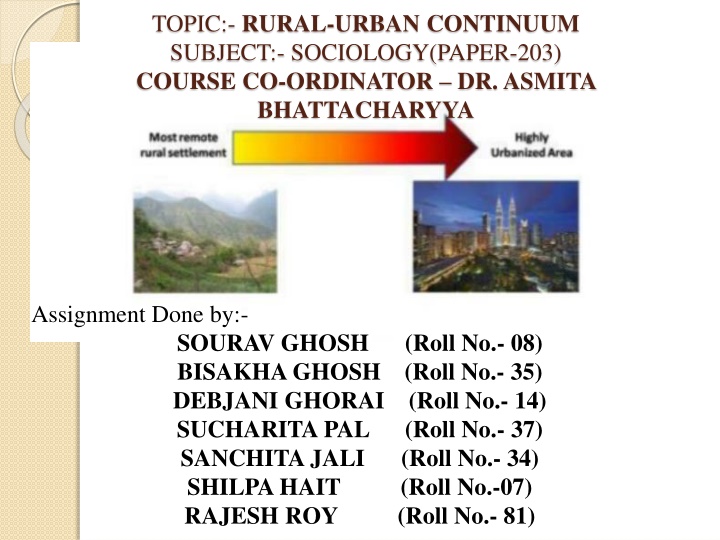
Understanding the Rural-Urban Continuum in Sociology
Learn about the meaning, definitions, characteristics, and importance of the rural-urban continuum in sociology. Explore how this concept reflects the socio-economic interactions between rural villages and urban cities, offering insights into population, lifestyle, and ecosystems.
Download Presentation

Please find below an Image/Link to download the presentation.
The content on the website is provided AS IS for your information and personal use only. It may not be sold, licensed, or shared on other websites without obtaining consent from the author. If you encounter any issues during the download, it is possible that the publisher has removed the file from their server.
You are allowed to download the files provided on this website for personal or commercial use, subject to the condition that they are used lawfully. All files are the property of their respective owners.
The content on the website is provided AS IS for your information and personal use only. It may not be sold, licensed, or shared on other websites without obtaining consent from the author.
E N D
Presentation Transcript
TOPIC:- RURAL-URBAN CONTINUUM SUBJECT:- SOCIOLOGY(PAPER-203) COURSE CO-ORDINATOR DR. ASMITA BHATTACHARYYA Assignment Done by:- SOURAV GHOSH (Roll No.- 08) BISAKHA GHOSH (Roll No.- 35) DEBJANI GHORAI (Roll No.- 14) SUCHARITA PAL (Roll No.- 37) SANCHITA JALI (Roll No.- 34) SHILPA HAIT (Roll No.-07) RAJESH ROY (Roll No.- 81)
Meaning & Concept of Rural Urban Continuum Meaning:- By Rural Urban Continuum is meant by continuity from village to the city. Robert Redfield(1930) has given the concept of rural urban continuum on the basis of his study of Mexican peasants of Tepoztlain. Therefore, rural urban continuum is a process of socio- economic interaction between the villages and the towns or cities. Rural urban continuum proposes a linear depiction of the contrasting natures of social relationships characteristic of rural & urban settlements, and there is no such breaking points in the degree of quantity of rural urban differences.
DEFINITIONS ON RURAL URBAN CONTINUUM According to P.A. Sorokin and Zimmerman, in Principles of Rural Urban Sociology have stated that the factors distinguishing rural from urban communities include occupation, size and density of population as well as mobility , differentiation and stratification. According to R.K. Mukherjee prefers the continuum model by talking of the degree of urbanization as a useful conceptual tool for understanding rural urban relations.
CHARACTERISTICS OF RURAL URBAN CONTINUUM RURAL CHARACTERISTICS i) Rural area is sparsely populated . URBAN CHARACTERISTICS i) Urban area is thickly populated . ii) Rural area is homogenous in nature. (dress, language and customs etc.) ii) Urban area is heterogeneous in nature. (castes, classes, ethnic groups , religions etc.) iii) Urban areas have got fast rate of change. iii) Rural areas have very slow rate of change. iv) Rural communities have got strong relationships and interactions of the people. v) Rural areas have got informal social life. iv) Urban areas have got weak interactions and ties on the basis of their complex . v) Urban areas have got formal social life . vi) In Rural areas there is less rate of pollution. vi) In Urban areas there is high rate of pollution.
IMPORTANCE OF RURAL URBAN CONTINUUM Overhelming of population. Both cities and villages create jobs and offer better livelihoods. Rural Urban continuum has enhanced rural production and productivity. 70% of rural- urban areas of population , are provided with medical care, recreational facility, education, transport and communication. Protecting local and regional ecosystems .
RURAL URBAN LINKAGES RURAL SYSTEMS URBAN SYSTEMS RURAL URBAN FLOWS NON AGRICULTURAL EMPLOYMENT PEOPLE URBAN SERVICES PRODUCTION SUPPLIES PRODUCTION SOCIO- ECONOMIC STRUCTURE AND RELATIONS NON DURABLE AND DURABLE FOODS COMMODITIES RURAL ECONOMY (SECTORS) MARKETS FOR SELLING RURAL PRODUCTS CAPITAL/INCOME RURAL PRODUCTION REGIMES PROCESSING / MANUFACTURING INFORMATION NATURAL RESOURCES INFORMATION ON EMPLOYMENT , PRODUCTION, PRICES, WELFARE SERVICES WASTE AND POLLUTION
CAUSES OF RURAL- URBAN CONTINUUM Migration Diminishing of politics Increasing number of people in employment Development of extensive road networks Demarcation process erases and clearing both the rural urban areas.
STAGES OF RURAL URBAN CONTINUUM As The Law Of Three Stages is an idea developed by Auguste Comte in society i) Theological stage ii) Metaphysical stage iii) Positive stage From rural to urban communities, the urbanization process started in 1940(Approximately) . Likewise ,on the basis of Population & Economic the Rural Urban continuum is classified into 4 stages by Gibbs & Hautamaki . The Pre- Industrial (Agricultural ) society . The concentration of the economy . Economic growth spreads across the country The spatial integration . i) ii) iii) iv)
SUSTAINABLE URBAN/RURAL LIVING CONDITIONS RURAL/URBAN INTER RELATIONSHIP RURAL URBAN Good Governance Good Land Policy CAPACITY BUILDING & DEVELOPMENT LAND & NATURAL RESOURCE INFRASTRUCTURES INSTITUTIONS & GOVERNANCE
Transport URBAN Knowledge Transfer RURAL Energy
SIGNIFICANCE OF RURAL- URBAN CONTINUUM Majority of the population in Rural Urban communities. The rural urban development is to organize , develop and utilize the resources of land , water and human resources. The rural- urban communities lead a simple lifestyle, large amount of effects and resources which accommodates the people enhancing the livelihoods . The rural urban areas are based on sustainability aspects to include environmental, social and economic dimensions.
RURAL URBAN CONTINUUM DEBATE It is noticed that both the concepts rural and urban communities are not adequately defined in a proper way. In western ideas and thoughts fail to fit the rural urban continuum into Indian reality . In rural urban communities, the people are in a difficulty of mode of life on the basis of no living amenities. There is a debate issue that there is no demarcation between the rural urban continuum and it is difficult to know where the urban area begin and the rural ends.
CONCLUSION In our opinion, the rural urban continuum , it is seen that the transformation of people from rural to urban areas are noteworthy. In rural areas and the allied issue of the urban bias is in a collective sense and therefore the rural urban continuum depends upon the specific zone in which the community falls . One thing is clear from the above all of the discussion is that the rural and urban life in complex relationship is not the opposite of one another. Spatial and geographical factors also influence and contribute towards the rural urban continuum . As it is a continue process , the socio- economic interaction between the village and towns are always liable to one another.
REFERENCES Bertrand A. (ed.),(1958) Rural Sociology, McGraw Hill Book Co., New York. Sharma, K.L. (1997) ,Rural Society in India, Rawat Publications, Jaipur. Desai A.R. (ed.) (1969), Rural Sociology in India, Popular Prakashan, Bombay. Anderson &Elijah (ed.), (1990) Race, Class & Change in an rural- urban community, Chicago Press.

